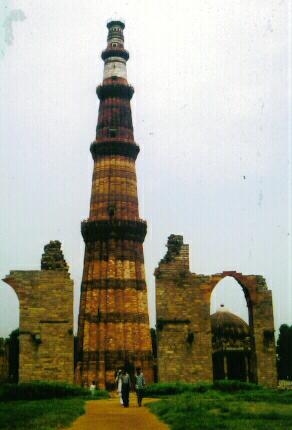|
|
Visit Indian Travel Sites
Goa,
Kerala,
Tamil Nadu,
Andhra Pradesh,
Delhi,
Rajasthan,
Uttar Pradesh,
Himachal Pradesh,
Assam,
Sikkim,
Karnataka,
Madhya Pradesh,
Jammu & Kashmir
Gujarat
Puducherry
|
|
|
|
Delhi Travel Sites
Delhi The Story
The Mughal Delhi, The Modern Delhi, Ashoka Pillar, Ghoonidarwaza
Places to see: Asoka Pillar, Red Fort, Jama Masjid, Chandni Chowk, Raj Ghat, Purana Qila, Humayun's tomb, India Gate, Birla House (Gandhi Smriti), Indira Gandhi Museum, Teen Murthi, Qutab Minar, Chhattarpur temple, Kalka Mandir, Bahaii temple, ISCON temple, Jantar Mantar, Hanuman Mandir, Connaught Place
5 |
|
|
|
Delhi - The Story
Delhi's past goes back to misty antiquity. Excavated pottery dating 1500 BC is quoted as evidence of a glorious, prehistoric
civilization. An Ashoka edict's discovery in Srinivaspuri
in the city in around 2000 AD indicates the region might
have been part of his empire. Time must have ravaged that
older civilization around Delhi. But the civilisation
that arose on its ruins from the outset of recorded history
in and around the hub of a tolerant people was trampled
upon by alien Muslim zealots without any revolt or serious
resistance. What really a visitor can look for today is
the monuments of the Muslim period dotting all over.
Muslim history begins with Mahmud of Ghor invading India and
defeating the Rajput king Prithviraj in 1192.
Where is Qutab, Qutb Minar, Who built Qutb Minar (Qutab Minar): Mahmud of Ghor's slave
Qutbuddin Aibak became the viceroy. In 1206, Qutbuddin
crowned himself as the sultan of the slave dynasty. He
is thus the first Muslim ruler of Delhi. Mosque came to
India, and alongwith, Islamic architecture. So also the
tomb. Qutbuddin built Quwwat-ul-Islam (might of Islam)
mosque. This is the earliest extant mosque in India. Qutb Minar (Qutab Minar) was also built by Qutbuddin.  | | Qutb Minar |
The Khiljis displaced the Slave dynasty in 1290. The Tughlaq dynasty displaced the Khiljis in 1321. Mohammad-bin-Tughlak's schemes were eccentric, most notorious being the shifting of the apital. Tughlaks disintegrated. Timur-i-Lang invaded
Delhi in 1398. Later came the Sayyids and Lodis. In 1526,
Zahir-ud-Din Babur defeated Rana Sanga (Sangram Singh)
and Ibrahim Lodi and founded the Mughal dynasty in Delhi.
He shifted the Capital to Agra. It remained the Mughal
Capital till 1648 when Shah Jahan finally shifted it back
to Delhi. The Mughal empire weakened gradually after the
death of Aurangzeb in 1707. Persian invader Nadir Shah
ravaged the city in 1739. The legendary Peacock Throne
(explained later) disappeared from Diwan-i-Khas (hall
of private audience) and later landed in the British museum
in London.
The Marathas, Sikhs and the British all fought for power.
The British got the upper hand in 1803. (See Ghoonidarwaza). After the Meerut mutiny of 1857, the
first Indian war of independence against the British,
the last Mughal titular emperor, Bahadur Shah Zafar, was
captured and exiled by the British. The British assumed
power. Another precious Indian relic, Koh-i-noor or Mount
of Light, one of the largest diamonds in the world, adorned
the British royal crown. Sporadic revolts against the
British soon grew into a widespread freedom struggle against
them. The spread of British education and ideas helped
unite the people in a spirit of nationalism. A larger,
democratic India was born in 1947.
Climate:Winter (Dec to Feb) Min 4 deg C, Summer (May and June) Max 45 deg C, July to Sept monsoon, Oct-Nov Feb-April ideal for visit.
Clothes: Cotton in summer and woollen in winter.
-R M Nair
|
|
|
|
|
|
|